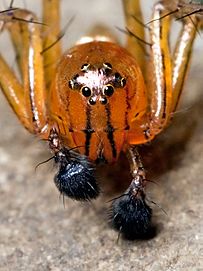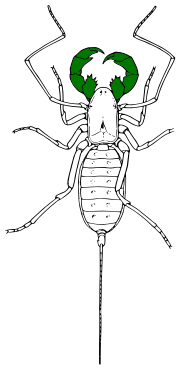Pedipalp facts for kids
Pedipalps are like two small arms on the front of a spider's head. They are not legs, but they can sometimes look like an extra pair of legs, making some spiders appear to have ten legs instead of eight. Spiders often use their pedipalps to hold insects like crickets while they eat them.
Male spiders also use their pedipalps for reproduction. They create a small silk web and put sperm onto it. Then, they dip their pedipalps into the sperm. The pedipalps then carry the sperm, allowing the male spider to mate with a female by placing them inside her epigynum.
Contents
What Are Pedipalps?
Pedipalps are special body parts found on arachnids, which include spiders, scorpions, and mites. They are located near the mouth and are used for many different tasks. Think of them as a spider's multi-tool!
How Spiders Use Pedipalps
Spiders use their pedipalps for several important jobs.
- Holding Food: One main use is to grab and hold prey, like insects, so the spider can eat them easily.
- Feeling and Tasting: Pedipalps can also help spiders explore their surroundings. They can feel textures and even "taste" things around them.
- Cleaning: Some spiders use their pedipalps to clean themselves, especially their fangs.
Pedipalps for Reproduction
For male spiders, pedipalps have a very special role in reproduction.
- Sperm Transfer: Male spiders don't have internal organs to transfer sperm directly. Instead, they use their pedipalps to pick up sperm and then transfer it to the female.
- Courtship: In some spider species, males use their pedipalps in special dances or movements to attract a female before mating.
Different Kinds of Pedipalps
Pedipalps are not just found on spiders; many other arachnids have them too, and they look and work differently.
- Pincers: Animals like scorpions and pseudoscorpions have pedipalps shaped like large pincers, which they use to catch prey.
- Leg-like: Some creatures, like Amblypygi (whip spiders), have very long, thin pedipalps that look like extra legs and are used for sensing.
- Antenna-like: The pedipalps of Solifugae (sun spiders) act like antennae, helping them feel their way around.
- Walking: Interestingly, Palpigradi (microwhip scorpions) use their pedipalps for moving around, which is quite unusual!
See also
 In Spanish: Pedipalpo para niños
In Spanish: Pedipalpo para niños



